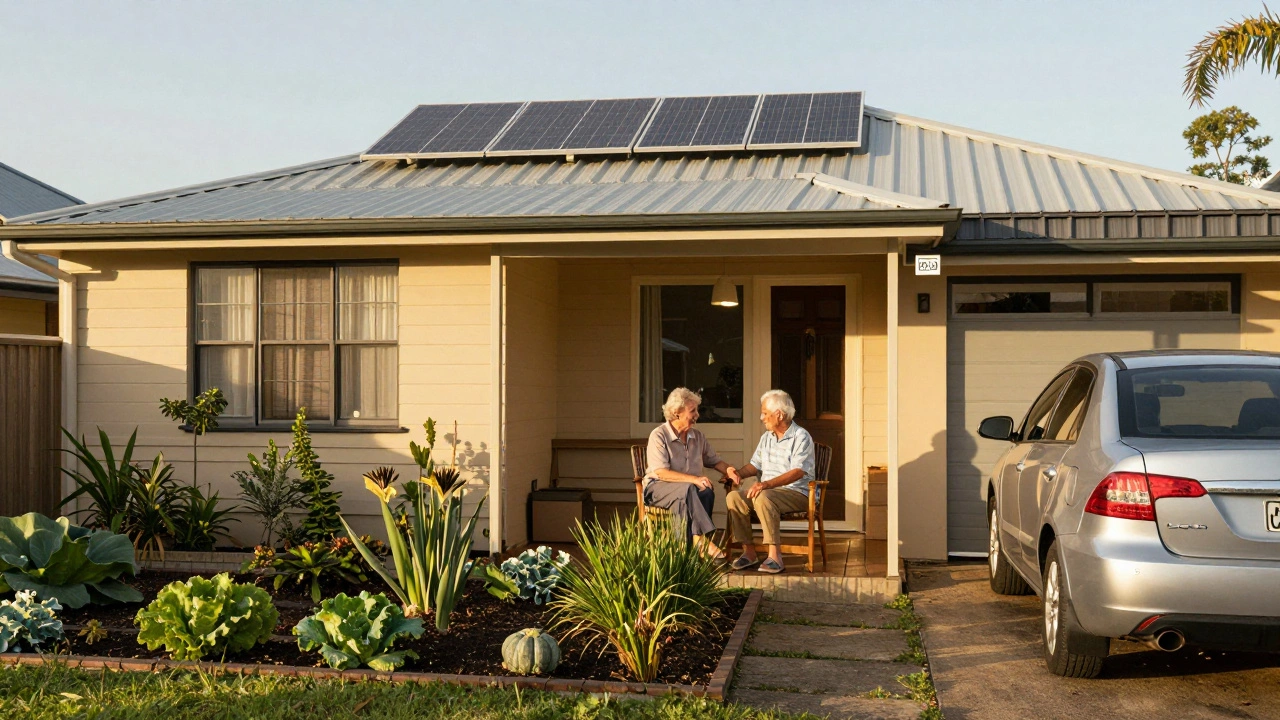You don’t always need a full-blown refinance to turn your bricks and mortar into money you can use. In Australia, you’ve got several ways to access equity sitting in your home-some quick and low-cost, others more structured. The catch? Each path comes with different rules, fees, and traps. If you just want cash for a reno or to tidy up debt, you’ll make different choices than if you’re funding an investment or you’re retired and want steady income. I’ll walk you through the options that work right now in 2025, how lenders think, and how to avoid paying for the wrong product.
TL;DR - Can you take equity out without refinancing?
- Yes. Common options include redraw, a loan “top-up” (increase), a home line of credit, a second mortgage, and reverse mortgage/HEAS for retirees.
- Start with the cheapest money: redraw and offset. If you need more, look at a loan increase or a line of credit. Only consider reverse mortgages or second mortgages when nothing else fits.
- Your practical limit is your loan-to-value ratio (LVR). Staying at or below 80% LVR usually avoids Lenders Mortgage Insurance (LMI).
- Banks test your ability to repay, often using a rate at least 3 percentage points higher than your actual rate (APRA guidance). So serviceability-not just equity-can be the handbrake.
- Tax rule of thumb (ATO): interest deductibility depends on what you use the borrowed funds for, not what the loan is secured against. Keep investment and personal borrowing separate.
home equity jobs you probably want to get done:
- See if I can tap equity without changing my current mortgage deal.
- Work out how much I can safely access before LMI kicks in.
- Pick the right product (redraw, top-up, LOC, second mortgage, reverse mortgage/HEAS) for my goal.
- Understand timing, costs, and what paperwork I’ll be asked for.
- Avoid tax mistakes and product traps that cost me later.
All the ways to tap equity without a full refinance (Australia, 2025)
Here’s what’s actually on the table in Australia right now. I live in Brisbane and see all of these in play across the big four and smaller lenders.
- Redraw facility - If you’ve paid extra into your home loan, you can usually redraw those extra repayments. This is the fastest and cheapest way to get money back. No new product, minimal paperwork. Caution: fixed-rate loans can throttle redraw; some lenders cap or restrict access.
- Offset account - Money sitting in your offset is yours to move. No credit assessment needed. The trade-off is your interest costs go up once you take the cash out, because your offset balance drops.
- Loan increase (a.k.a. top-up) - You keep your existing mortgage, but the bank increases your limit. It’s not a full refinance, but expect a new credit assessment, updated valuation, and fresh documents. Great when you need more than you’ve got in redraw/offset. Staying ≤80% LVR helps you dodge LMI.
- Home line of credit (LOC) - Works like a giant credit card against your home. You can draw and repay as needed. Suits irregular projects or investing. Be honest with yourself: LOCs demand discipline; interest-only periods can leave the principal untouched for years if you’re not careful.
- Second mortgage / caveat loan - Another lender sits behind your main bank and lends against your leftover equity. It can be fast, but rates and fees are higher and legal work is fiddly because your first lender needs to consent. Use only for short-term needs with a clear exit plan.
- Reverse mortgage (typically 60+ age) - No repayments required until you sell, move out long-term, or pass away. Good for retirees wanting to supplement cash flow while staying in their home. ASIC’s MoneySmart warns about compounding interest and the impact on your estate; talk to your family and get advice.
- Home Equity Access Scheme (HEAS) - Run by Services Australia. If you’re of Age Pension age and meet eligibility, it lets you unlock equity as a fortnightly payment or lump sum, secured by your home. It’s not free money-it’s a government loan with interest, and it’s flexible. Worth a look before commercial reverse mortgages.
What doesn’t count as “without refinancing”?
- Cash-out refinance - You replace your whole home loan with a new one and pull out equity at the same time. It can grab a better rate but it is a refinance. Useful if your current deal is bad, not if you want to keep it.
- Debt consolidation via refinance - Also a refinance. Helpful in the right case, but outside our scope here.
Two Aussie-specific notes:
- LVR and LMI - Most lenders cap you at 80% LVR without LMI. If you go above 80%, the premium can be thousands. Some lenders allow cash-out past 80% only for very tight use-cases.
- Serviceability buffer - Banks stress-test your repayments at a higher rate than the one you’ll actually pay (APRA guidance). If rates have risen since you first borrowed, this can limit your top-up size-even if you’ve got plenty of equity on paper.

How to pick the right option and apply (step-by-step + decision tree)
Use this simple flow before you speak to a bank or broker. It saves time and awkward surprises.
- Check your redraw/offset first. Log in and see what’s available. If your need fits that amount, it’s usually the cheapest path.
- Estimate your accessible equity. Order a free bank estimate or a paid valuation if you want certainty. Use the 80% rule of thumb: Accessible equity before LMI ≈ (Property value × 0.80) − Current loan balance.
- Match product to purpose.
- One-off spend (reno/car/school fees): Top-up or redraw.
- Staggered spend or investing: Line of credit, or a top-up split into a separate, interest-only loan.
- Short-term bridge: Second mortgage only if you have a clear exit (e.g., asset sale or refinance later).
- Retired, want income: Reverse mortgage or HEAS.
- Keep loans “clean” for tax. If funds are for investing, set up a separate loan split so the interest is easy to track for the ATO. Mixing personal and investment uses in one loan muddies deductions.
- Run a serviceability check. Expect the lender to test you at a higher “buffered” rate and consider your living expenses, debts, and dependants. If your budget is tight, a smaller top-up or interest-only period might be the only approval path.
- Collect documents. Typical asks: payslips or tax returns (self-employed: two years), ID, statements for all debts, rates notice, building insurance, and a purpose statement for cash-out.
- Prepare for a valuation. Tidy, list your improvements, and share recent comparable sales. A higher valuation can boost accessible equity and reduce LMI risk.
- Watch fees and timelines. Variations/top-ups can be approved inside 1-3 weeks; lines of credit similar. Second mortgages can be faster but costlier. Reverse mortgages take longer because of counselling and legal checks.
Decision mini-tree:
- If you have enough in redraw/offset → Use that.
- If you need more and can service the debt at 80% LVR or less → Request a loan increase or LOC.
- If you’re over 60 and prefer no repayments → Weigh HEAS vs reverse mortgage.
- If banks say no and you have a short-term plan to repay → Consider a small second mortgage with caution.
- If your current rate is bad and you need cash-out anyway → A full refinance with cash-out might actually be the smarter move.
Numbers that matter: LVR, borrowing power, and examples
Let’s anchor this with practical maths you can copy into your notes.
Key formulas:
- Equity (paper): Property value − Current loan balance.
- Accessible equity before LMI (rule of thumb): (Property value × 0.80) − Current loan balance.
- Post-draw LVR: (New total loan balance ÷ Property value) × 100.
Worked examples:
- Brisbane house worth $900,000; loan $480,000. 80% of value = $720,000. Accessible equity before LMI ≈ $720,000 − $480,000 = $240,000. If you’ve got $30,000 in offset, you may not need a top-up for a small reno-use offset first.
- Unit worth $650,000; loan $560,000. 80% = $520,000. You’re already above that at ~86% LVR, so no top-up without LMI. Redraw/offset are your only quick options.
- House worth $1.2m; loan $650,000. 80% = $960,000. Accessible equity ≈ $310,000. Whether you can borrow it all depends on serviceability under the bank’s buffer.
| Scenario | Property Value | Current Loan | 80% of Value | Accessible Equity (≤80% LVR) | Likely Path | Notes |
|---|---|---|---|---|---|---|
| Owner-occupier, Brisbane | $900,000 | $480,000 | $720,000 | $240,000 | Redraw/Top-up/LOC | Serviceability sets the cap; staying ≤80% avoids LMI. |
| High LVR unit | $650,000 | $560,000 | $520,000 | $0 | Redraw/Offset only | Already >80% LVR. LMI likely if borrowing more. |
| Investor, dual income | $1,200,000 | $650,000 | $960,000 | $310,000 | Top-up + new split or LOC | Keep investment split separate for tax tracking. |
| Retiree couple | $800,000 | $0 | $640,000 | Depends on provider | HEAS or reverse mortgage | No repayments with RM; compounding interest reduces estate. |
Checklist: what lenders look at for top-ups/LOCs
- Income stability (PAYG: recent payslips; self-employed: tax returns and assessments).
- Other debts (credit cards, car loans, HECS/HELP).
- Living expenses (yes, they’ll ask line-by-line).
- Property type (apartments in dense areas can have tighter policy).
- Purpose of funds (renovation quotes, investment plan, or debts to be cleared).

Risks, tax quirks, and fast answers (mini‑FAQ + pitfalls + next steps)
Here’s the straight talk I give friends and clients.
- Redraw vs offset: Redraw can be limited on some fixed loans and may require a request; offset is instant. Either way, pulling money out raises your interest bill because your net balance rises.
- Don’t mix purposes: The ATO focuses on how you use borrowed money. If you borrow for shares or an investment property, interest may be deductible. If you borrow for a car holiday or school fees, it’s not. Mixing uses in one loan creates ugly bookkeeping and can reduce deductions. Create separate splits.
- Serviceability buffer hurts more in 2025: If rates rose since you took out the loan, the current buffer test can slash your borrowing power even if your on-time repayment history is spotless.
- LMI isn’t small change: Going above 80% LVR can attract a chunky LMI premium. Sometimes paying LMI makes sense (e.g., high-return investment), but it’s rarely Plan A to pull equity for personal spending.
- LOC discipline: Lines of credit are flexible, but that flexibility burns people. If you only ever pay interest, your balance never falls. Set rules-automatic transfers or a plan to convert to principal-and-interest later.
- Second mortgages are stopgaps: They can rescue a timeline, but rates and fees are higher, and your first lender must consent. Have a defined exit (sale, refinance later) before you sign.
- Reverse mortgage safety nets: Australian providers must offer a no negative equity guarantee, but compounding interest can still eat a big chunk of your estate. ASIC recommends independent legal and financial advice. Services Australia’s HEAS is an alternative worth comparing.
- Fixed loans and break costs: You’re not refinancing, so you avoid break costs-but check your fixed-rate terms. Some lenders limit redraw or top-up during a fixed period.
Mini‑FAQ
- Is a top-up considered a refinance? No. It’s a variation to your existing loan. You keep your lender and most terms, but you still face a fresh credit assessment.
- Do I need a valuation? Usually yes for a top-up, LOC, or reverse mortgage. Redraw/offset generally don’t need one.
- How fast can I get funds? Redraw/offset: same day. Top-ups/LOCs: roughly 1-3 weeks depending on valuation timing. Second mortgages: can be fast, but paperwork and consents vary.
- Will this hit my credit score? A top-up/LOC application triggers a credit enquiry. A redraw/offset transfer doesn’t.
- Can I access equity if I’m self‑employed? Yes, but banks want two years of financials or a strong alternative. A good broker helps present your case cleanly.
- What if my property value has dipped? Your accessible equity shrinks. If you’re above 80% LVR already, options narrow to redraw/offset unless you pay LMI or wait.
- Are reverse mortgage rates higher? Generally yes relative to standard home loans. Weigh that carefully against the benefit of no required repayments.
Next steps
- Homeowner with extra repayments: Use redraw/offset for small needs. If you need more, split a top-up into a new account so you can track the purpose.
- Investor planning ahead: Consider a LOC or a dedicated interest‑only split for investment expenses. Keep the loan purpose clean for ATO reporting.
- On a tight budget in 2025: Borrow less than the full accessible equity, and try to stay ≤80% LVR. Ask your lender to model repayments under rate rises.
- Retiree weighing options: Compare HEAS and reverse mortgages side by side. Speak with Services Australia and get independent advice before signing anything.
- Denied by your bank: Ask for the reasons in writing (LVR, serviceability, credit file). A broker can shop policy differences across lenders or suggest a staged plan.
Who says this?
- APRA sets prudential guidance; banks typically apply a serviceability buffer above your rate.
- ATO rules on interest deductibility are purpose‑based-separate your loans by use.
- ASIC MoneySmart publishes clear warnings and calculators for reverse mortgages.
- Services Australia runs the Home Equity Access Scheme for eligible retirees.
If you want cash without tearing up your current home loan, start with what you already have: redraw and offset. If that’s not enough, a top-up or LOC gets you there without a full refinance-just be ready for a valuation and fresh checks. Above all, keep your purposes separate and your LVR sensible. That one habit saves people more money than chasing the perfect rate.









